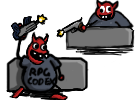On the TT a system has to so simple that a human can keep it memorised. It has to be so consistent that humans can expand on it on the fly without disagreeing how. It has to somehow be engaging/fun to wield. And humans have to be able to use it at a high enough pace that they don't fall asleep.
Dice aren't required for any of that, but they can be extremely useful for all of it.
If, however, the system is wielded exclusively by a machine, none of those things are a concern. If a random value between 1 and 7 makes the most sense in some very rare situation, you don't have to use a d6 or d8 instead. And you don't have to resolve the very rare situation in a way that is mechanically consistent with how you resolve other events.
Dice are unnecessarily restrictive with no advantages.
The difference greatly depends on how much complexity is poured into the resolution system - most of them probably aren't going to go the route of a Jagged Alliance 2, and if they aren't, 'virtual dice' are about as effective as they need, and stealing all sorts of playtest and actual game revision time from whatever system they're emulating that they only have to tinker with as apposed to build from the ground up. If they build it from scratch they are basically throwing away an already established system of balance and thinking they can do better, which as you've said, is generally exposed as horseshit, with some exceptions (due to strong tactical focus). What most of them end up doing is dumb it down even
further from the moderate base of many PnP systems to better suit their Decline.
One also has to consider whether they want a true '1-1000' % roll or create more of a bell-curve base akin to systems like GURPS or HERO that use just that via a 3d6, roll under base (though roll under is mostly to keep numbers quite low and thus speed the PnP calculations). Naturally this and more is possible through the computer format doing it behind the scenes, but it's wise to consider there is an effective balance to using small, simple numbers beyond the necessities of PnP play. These systems have been answering the very CRPG relevant questions of 'what can this player-controlled character simulation do, and how does it interact with the mechanics of the system?' for quite a while and I don't really see the point in reinventing it's wheel when CRPGS haven't even matched them with few exceptions. Better to draw on that as much as possible.
The possibilities of player imagination at the game table far exceed the capability of CRPG design, and if the PnP system is one that supports that imagination, the CRPG designers are going to be dumbing it down no matter what. No doubt that is part of the motivation for creating a shitty facsimile of a PnP system from scratch. Why bother using something good at base, just to make shit?
Preferably the designers would take such a system and just tweak it down to a healthy moderate version instead of Retardville Custom System #93, or something that would be 'too' tactical for the storyfags, if you will.
Granted, I wouldn't mind a full representation of some of the more tactically varied, 'include most possibilities' modern PnP systems, but it isn't always necessarily the goal of a good CRPG.




























![Glory to Codexia! [2012] Codex 2012](/forums/smiles/campaign_tags/campaign_slushfund2012.png)
![Have Many Potato [2013] Codex 2013](/forums/smiles/campaign_tags/campaign_potato2013.png)
![The Year of Incline [2014] Codex 2014](/forums/smiles/campaign_tags/campaign_incline2014.png)












